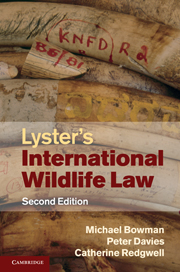Book contents
- Frontmatter
- Contents
- Foreword
- Preface
- List of abbreviations
- PART I Foundations of international wildlife law
- PART II Species regulation
- PART III Regional wildlife regulation
- PART IV Global wildlife regulation
- PART V Biological diversity: a new perspective on wildlife regulation
- 17 The Biodiversity Convention and Biosafety Protocol
- 18 Deserts, forests and mountains
- PART VI Cross-sectoral issues in wildlife regulation
- PART VII Conclusion
- Index
- References
18 - Deserts, forests and mountains
Published online by Cambridge University Press: 05 July 2011
- Frontmatter
- Contents
- Foreword
- Preface
- List of abbreviations
- PART I Foundations of international wildlife law
- PART II Species regulation
- PART III Regional wildlife regulation
- PART IV Global wildlife regulation
- PART V Biological diversity: a new perspective on wildlife regulation
- 17 The Biodiversity Convention and Biosafety Protocol
- 18 Deserts, forests and mountains
- PART VI Cross-sectoral issues in wildlife regulation
- PART VII Conclusion
- Index
- References
Summary
Introduction
It was hoped that the Rio process would bring about not only a convention conserving biodiversity but also conventions on desertification and forests. From 1975 onwards, the UN, UNEP, and various conferences of concerned international organisations and bodies had drawn attention to the increasingly serious environmental and economic consequences of the expansion of arid lands and destruction of forests, especially tropical forests. Various recommendations emerged from these and were promoted by, inter alia, UNEP, UNESCO, and the FAO, but action lagged until the spread and severity of desertification and rate of destruction of forests led to intensified demands for action. This was inhibited, however, by the insistence of some states that the issues involved fell wholly within their national sovereignty. Thus, although some progress was made on definitional aspects, the goal of concluding conventions on these topics was not attained at UNCED, though Agenda 21 did define and draw attention to desertification, and a non-binding statement of principles relating to forests was adopted. It was not until 1994 that a Convention to Combat Desertification was adopted; to date, no global agreement on binding standards for the protection of forests has been reached.
Agenda 21 also called for regional legal and other instruments to protect fragile mountain ecosystems, with a step in this direction taken the previous year with the conclusion of the 1991 Alps Convention in Europe.
- Type
- Chapter
- Information
- Lyster's International Wildlife Law , pp. 630 - 648Publisher: Cambridge University PressPrint publication year: 2010



